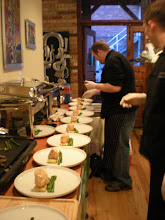Tuesday, August 31, 2010
Finally, finished.
Wednesday, June 9, 2010
Day One: Alinea with Grant Achatz

6/8/2010 R.M.S.
Day one: Grant Achatz; Alinea
Alinea reflects a dedication towards perfection. Time limit, money and rarity of ingredient of not apply once the idea is formed. Not many kitchens, nor many chefs are willing to put fourth such a sacrifice. From the earth to where our ingredients come from, we can never compromise if we want to truly be masters of our craft. If we compromise at the core, the outer exteriors will not hold strong. They will crumble from the base. Just like with sauces, you need good fond; you need a good base.
A beautiful aspect of the Achatz mission statement is the concept of not overlooking a single aspect, component or angle. I refer to Grant’s thoughts on a “palate cleansing” course; he takes the familiarity of a smooth textures when referring to the course. And instead of going sweet, he maintains the flavor profile of a true basic flavor spectrum, lettuces or greens. The greens will have their on depth based on they are brought up and cared for, but in his theories there is not additional flavors needed. He takes lettuces or greens and juices them, and makes a granite from said juices. I like the idea of getting away from a “sweeter” intermezzo. It’s too easy to revert back to a “sorbet” for that course, yet the simpler route which no one takes is right in front of us. I don’t delve into the subject much, but it does really showcase the importance of textures in our dining experiences. The texture of something carries out through the entire eating process. From the first crunch, or lack thereof, to the last mushy bite as we finish the morsels. But all textures aside, it still comes down to quality base ingredients.
While going through just the first few chapters of Alinea, I have stumbled unto new (at least for me) recipe development. And that is not listing the portion of ingredients by anything other than gram weight. That is instead of ounces or fluid milliliters I will list everything by its metric weight. It is far more accurate, and when dealing with such fussy ingredients, accuracy is essential to the success of the component or dish. I am really regretting that I had not sooner gone through this book. As I now am dabbling into these techniques on my own, using this tome prior would have saved me so much time and failed experiments. Alas, it’s all part of the learning process. I am about half way through Alinea and am looking forward to the rest of the book for the opportunity to learn. Achatz has done well with deconstructions and reassemblies of components, flavors and ingredients. Alinea is a great resource for learning about molecular gastronomy as well. Alinea, as I am just getting into it, will prove to be a great base for my knowledge.
I think I will finish out my evening by watching “L’invention de la cuisine with Pierre Gagnaire”. It’s a documentary about him and his cuisine and current food trends. Time to learn about his base and where he comes from.
Ryan Michael Stoy
